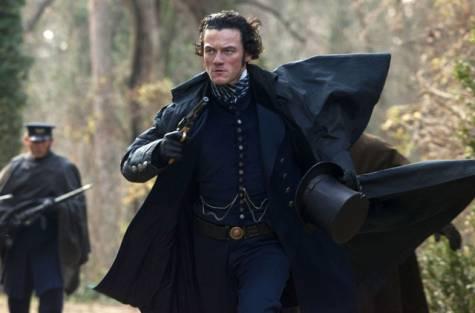 |
| Hi! I'm John Cusack and way hotter than the original. |
Atmospheric, dreary, dark, claustrophobic, police-procedural, inventive, gory, blood-spurted and melancholy The Raven pits the world's greatest horror writer against a serial killer inspired to copycat his most famous works: The Pit and the Pendulum, The Mask of the Red Death, The Cask of Amantillado: if you have a weak stomach or thought that life-sized representations of the stories that kept you up at night would send you over the brink, then this is not the tale for you. However, if you are fascinated to follow the breadcrumb trail of links and clues that lead you to search the recesses of your mind to excavate what you remember from the Poe canon, then hurrah!... this is JUST like that episode of Castle where a criminal is inspired by Richard Castle's most famous novels and crimes ....except here.... the stalwart Inspector Fields of the Baltimore PD goes straight to POE --- the greatest horror writer and the greatest inventor of melancholia.
For those of us who know about Poe's life: his mysterious disappearance, his struggle to reconcile himself with his stand-up West Point career and this wife's death with the raging blood-red circumference of his imagination, his odd eccentricities, his alcoholism and his utter despair are couched here in the capable underplay of John Cusack. There is enough fact blended in this utter fan fiction to give it some historical weight. Not unlike the Guy Ritchie retellings of Sherlock Holmes, 1849 Baltimore, here, is a grey and bleak world of stolen shadows across cobblestones, sleek rain-slated windows and carriages groaning under devious weight. And, speaking of Sherlock, we remember Watson mentioning Dupin don't we? In Study in Scarlet ? Yes. Yes we do!
 |
| I am over-acting in this scene, as I do all; but look! my coat! it doth swing! |
This is very much a police procedural and the smell of ink and death and the painful re-creation of horrendous Poe inspirations are all in front of you: so, if you have a weak stomach, this is not your film. The horror, I must say, had a more grotesque "cartoony" feel which very much left it in the realm of popular imagination. I enjoyed how Poe was regaled and horrified by seeing his work in actual light... how he struggled with the fact that his brilliant mind was responsible for inhuman horror. Also, the story meandered into the realm (if weakly) of what is fact and fiction and at one point do authors become characters in their own stories: borne of the weaknesses subjected by the wrong interpretation of their work.
[---Also, Edgar Allen Poe has a pet raccoon..... and he quoths the Raven at a pub where Higgins from N and S/ Bates from Downton is the barkeep.... true story]
An entirely amusing 2 hours at the movies and the perfect ending to a road-trip weekend I took through Kingston and Prince Edward County with two girlfriends. We chuckled a lot at some of the reprehensibly cheesy lines and at Luke Evans attempt to chew the scenery, swallow it, spit it out and chew it again (he really was terrible in this film: interesting to note that Jeremy Renner was a first choice).
So, there it is: fan fiction on screen.....










